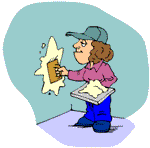 Making plaster wall repairs can be a little different than repairing drywall, why? For one thing plaster is installed differently than drywall. Drywall comes in sheets, two pieces of paper with a gypsum core in the middle. Only the seams receive drywall compound to finish it off.
Making plaster wall repairs can be a little different than repairing drywall, why? For one thing plaster is installed differently than drywall. Drywall comes in sheets, two pieces of paper with a gypsum core in the middle. Only the seams receive drywall compound to finish it off.
Plaster and drywall are sometimes used interchangeably, not sure if you have a plaster wall? See the article 'How To Patch Walls and Ceilings' and 'Drywall Repair Problems' for a listing of all the topics.
An old style plaster wall is installed with three coats of troweled material over a substrate. Plaster requires a lot more skill than drywall, not to mention a lot more work. When the plaster dries the coats bond together into one monolithic wall or ceiling. How difficult it is to repair plaster is determined by how stable the plaster is now.
Small repairs can be done with drywall compound and drywall tape. It is even possible to use pieces of drywall to make larger repairs. Plaster is a gypsum based product, the same as drywall, so the two materials are compatible.
Plaster Wall Repairs - Information
What Can You Save?
There is a wide range of cost for this type of repair. The minimum would be around $100 with several hundred or even thousands possible. Drywall and plaster repairs often require, multiple steps, thus increasing the cost.
How Hard Could It Be?
Plaster wall repairs involve both work and skill. With a little practice, the skill can be acquired. You will not be able to get around the work.
Check the Simple Things!
You can fix minor cracks and holes with spackling. You can purchase a small can at a home supply store. See the article 'How To Spackle Drywall' for instructions on this easy repair. The article 'How To Repair Drywall', provides a general discussion on wall and ceiling repair topics.
What Can Go Wrong?
Plaster wall repairs and their cousins, drywall patching, can be a messy job. Drywall or plaster dust is very fine and gets everywhere. Take precautions and protect the area. Using some plastic to close off the area is a good idea. Getting a good finish on the repair will take some practice. You may have to put an extra coat or two on, with some sanding in between. See the article 'Taping and Mudding Drywall' for some pointers on working with drywall compound.
Troubleshooting Plaster Wall Problems
Fixing small holes and dings in plaster walls is the same as a drywall wall. 'Spackling Plaster Walls' covers this topic.
When you have a bigger hole in your wall it is more of a problem. The article 'Fixing Holes in Plaster Walls' covered what can be done and how to fix it.
Plaster products are less common than drywall. They are also harder to use. Since plaster and drywall are made from the same materials, can they be mixed? The article 'Using Drywall on Plaster Walls' covered how to do this.
Plaster is similar to drywall, since it is made from the same products. However, the way it is installed is completely different. Human error is also a factor with plaster. Over time plaster can fail and start to fall off the wall. The article 'Plaster Wall Failure' discussed what can be done when this happens.
Summary
Do you have plaster walls in your home? At first you may be intimidated with the thought of trying to repair them. There is no need for fear. Plaster and drywall are very similar. In fact plaster was the predecessor of drywall and in many ways if very similar.
Hopefully, you were able to obtain some the materials at a home supply store that worked on your problem. Once it is sanded, a smooth drywall surface can look as good as a plaster wall. Now that this project is complete, you can move on to other home repairs.

